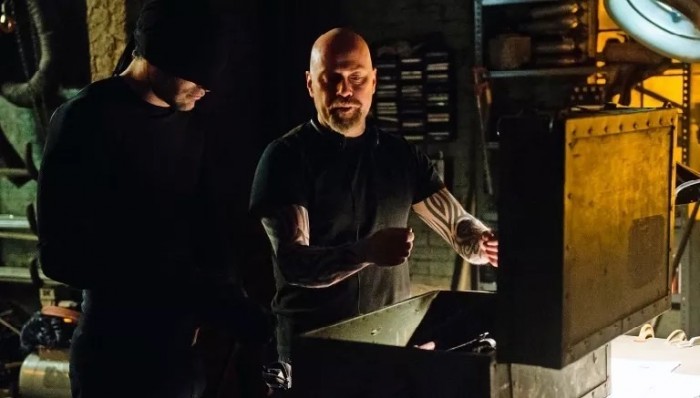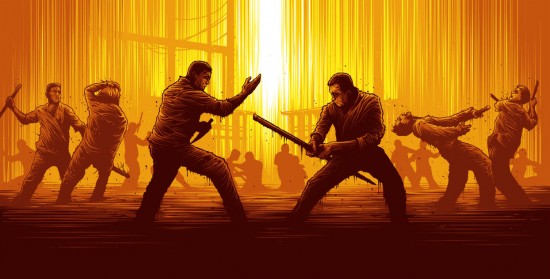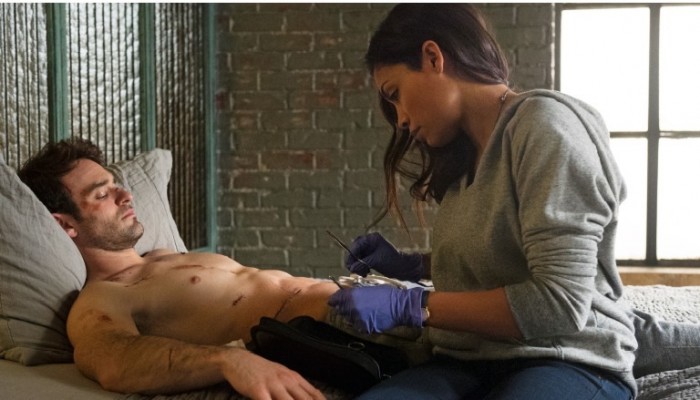Daredevil Fight Scene: How They Pulled Off That Five And A Half Minute Shot
One of our favorite moments from Daredevil is the climactic fight sequence which ends Episode 2. Its probably my favorite television action sequence in recent years. So when I got a chance to talk to the cast and crew of Daredevil, all I wanted to know was how they pulled off that sequence. For those of you who haven't yet watched the Netflix television series, the second episode ends with Daredevil in full vigilante mode, attempting to break into a baddie's hideout to save someone.
The sequence lasts five and a half minutes long, with a three-minute fight in the middle, and is incredibly well choreographed. When I first saw it I almost stopped breathing as I realized the beauty of this single take. I'll admit, it looks like the shot could be visually stitched together using three different takes (as was done in Birdman) but and according to those involved, the fight scene you see is the result of one lone single shot. Lets find out how they did that Daredevil fight scene, after the jump.
Daredevil Fight Scene in Hallway
For those of you who haven't seen the sequence, above is a 3-minute segment of the action sequence in question. The scene in the show has more to it at the header and footer. The scene begins almost 46 minutes into the second episode, with the camera following a Russian mobster to give us the layout of this hallway hideout. You then see the action in the clip above, and the whole thing concludes with Daredevil unlocking the door and entering to save the kid on the other side. He carries the kid out of the hideout, stepping over the piles of wasted Russians as the camera tracks back down hallway in front of them, giving us glimpses into the rooms.
 Peter Sciretta: In Episode 2, one of the my favorite moments in the show is the ending fight sequence, the five and a half minute sequence.Steven DeKnight: Ah yes.Peter Sciretta: I was wondering if you could talk about that. How was that put together? What was the thought behind that?Steven DeKnight: Sure. You know, when I first came onto the show, when I took over for Drew Goddard, who had to leave to do the Sinister Six movie, the first two episodes were written. So I got to the end of reading that Episode 2 thing and, you know, it was described as this long, continuous fight in a hallway. And I thought oh that's great. I don't know how the hell we'll ever be able to do it, but that's great. So the next key was our Stunt Coordinator and we hired Philip Silvera. If you remember the elevator sequence from Winter Soldier, he's actually one of the guys in that sequence, which I didn't know until much later. But he had worked with Marvel before. And he gave us a great test reel for the fight in the Episode 1. He put together a little test and he said, that's exactly it. I had always approached it this way as I wanted this world to be very grounded.
Peter Sciretta: In Episode 2, one of the my favorite moments in the show is the ending fight sequence, the five and a half minute sequence.Steven DeKnight: Ah yes.Peter Sciretta: I was wondering if you could talk about that. How was that put together? What was the thought behind that?Steven DeKnight: Sure. You know, when I first came onto the show, when I took over for Drew Goddard, who had to leave to do the Sinister Six movie, the first two episodes were written. So I got to the end of reading that Episode 2 thing and, you know, it was described as this long, continuous fight in a hallway. And I thought oh that's great. I don't know how the hell we'll ever be able to do it, but that's great. So the next key was our Stunt Coordinator and we hired Philip Silvera. If you remember the elevator sequence from Winter Soldier, he's actually one of the guys in that sequence, which I didn't know until much later. But he had worked with Marvel before. And he gave us a great test reel for the fight in the Episode 1. He put together a little test and he said, that's exactly it. I had always approached it this way as I wanted this world to be very grounded.
So we wanted more Jason Bourne, The Raid movies and not a lot of flying wire CGI stunts. And then he was instrumental. He brought in a fantastic stunt guy, Chris Brewster, who doubled Chris Evans in The Winter Soldier. So he was our main double for Charlie for some of the more extreme stuff.
Peter: Now tell me this, Is that one single shot or is that three? It looked like it could be three stitched together.Steven DeKnight: You know, I'm not sure myself. We did multiple takes but it was all designed to be one continuous shot.
***
For the answer to that question we spoke to actor Charlie Cox who plays Matt Murdock, aka Daredevil. He explains how this masterful fight sequence was executed. Learn more, after the jump.
I later asked Charlie Cox who plays Matt Murdock/Daredevil about the sequence during a round table interview with Rosario Dawson:
Peter Sciretta: One of our favorite parts of the five episodes we've seen is the end of the second episode, the fight sequence that's like six minutes long and it looks like one take.Charlie Cox: No one has said that.Peter Sciretta: Really?Charlie Cox: No, I'm kidding.Peter Sciretta: I was gonna say, 'cause that's incredible. I wanted to hear your experience filming that and how it went.Charlie Cox: Yeah. Poor Rosario's gonna be bored of hearing this. So it was–Rosario Dawson: No, I love it so much.Charlie Cox: It was incredible. It was as a special day as it was to as the scene has turned out. We dedicated our whole day to it. The first half of the day was just the camera movements. And then we got into, it was as you know it's one take, so we had to get everything right. Each attempt that we had at it. And it's incredibly tricky because it's not like a long tracking shot with two people speaking, it's a long tracking shot with people punching. And if one punch doesn't land, it no longer works. It ceases to work as a scene. So I think we did it 12 times. I think three of them we made it all the way through to the end. And one of them was the one in the show, which is kind of almost flawless. I mean, it's very hard to pick holes in that.Peter Sciretta: So its really not stitched together at all?Charlie Cox: No, that's one take. And...Rosario Dawson: The choreography though, that's what kills me about it, 'caus just that whole idea of when you're seeing it and it's not static, it's not just looking in one direction, it moves, it goes and it looks in other places. The camera, it–Charlie Cox: It tells a story.
Rosario Dawson: They change places and so like I've done enough, you know, I didn't film anything like that, but, you know, I remember when we did the scene in Death Proof and we're all around the table and the camera's moving around and, you know, we choreographed this whole thing where we lean forward so we could in one shot we could get close-ups and two takes, whatever, so I knew exactly what was going on, but the fact that it wasn't on a track, this is someone walking around. He's dipping, like it's seamless, you know. There's points where he's acting, where he's fighting and all of a sudden–Charlie Cox: I come in and I go in a door, I hide behind the door, Chris Brewster comes out, he does his bit. Then he goes into a room, I come back out, I do a bit and, you know.Rosario Dawson: It's just, it's beautiful. And also it takes its time. There's still, like, breathing. There are so many people. Just the reality of how much, you know, how every single person I'm sure that day was like "huh," at the top of it. And that's what makes shooting something like this so exciting because you're Daredevil, but we're all Daredevil. Like, you know, we're all these different characters. Like it's means so much to every single person on set to get it right. Whatever that means and there's so many disparate ideas and views of what that is, but you know you got it when at the end of a take like that, everyone just goes yeah. There's an immediate release that you don't normally get on set, you know. Like people don't normally cheer like that on dramatic film and indie films.Charlie Cox: Yeah, it was a bonding moment.Rosario Dawson: It's beautiful and I love remembering everybody else who was there. You know, because from the producers down every single person is a part of that camera movement. If it doesn't work, it's like aw... You know? But when it does, it's so powerful. And we're on vampire hours. Most of the time, the whole crew, everybody, we're working late at night. I'm very good at that. I love being up super late at night, but it's hard. And I think what's great about it is that it's not supposed to be flawless and perfect. You know, it's not supposed to be like these invincible characters fighting each other, it's supposed to be real. It's supposed to be real people. And I think that's gonna get people in the room to kind of like pant with you. You know, like we were panting at the end of these takes. We're not faking that.
Hallway Fight Scene: Oldboy v. Daredevil Analysis

